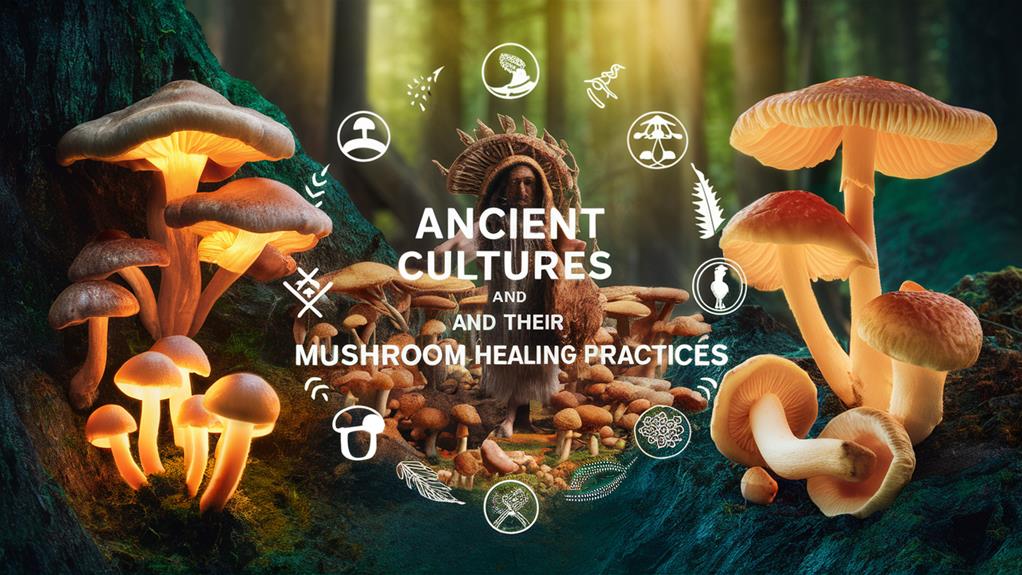
Ancient cultures recognized mushrooms as powerful healers, using them in both medical and spiritual practices. For instance, Hippocrates noted their anti-inflammatory benefits, while Chinese texts highlighted mushrooms like reishi for health and longevity. Many tribes, including Indigenous North Americans, used mushrooms for wound healing and spiritual rituals. Psychoactive mushrooms played a crucial role in ceremonies across Mesoamerica, connecting people to the divine. Today, modern science supports these ancient views, confirming mushrooms' medicinal properties. By exploring these historical practices, you'll uncover how ancient wisdom is being applied in today's health and wellness world.
Historical Context of Mushroom Use
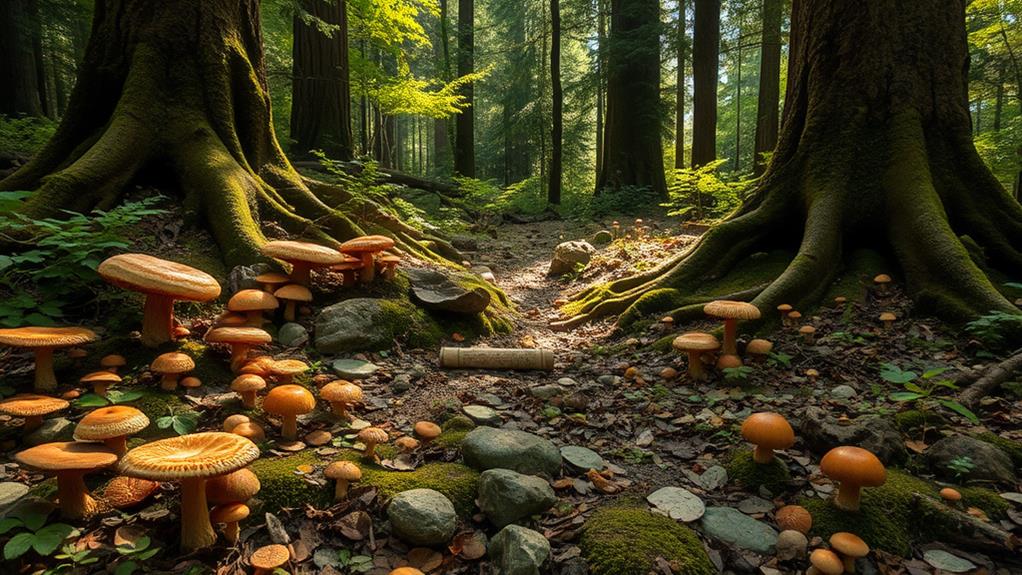
Throughout history, various ancient cultures have recognized the remarkable healing properties of mushrooms. These fascinating fungi played a crucial role in traditional healing practices across the globe. For instance, around 450 BCE, Hippocrates, often called the father of medicine, classified the amadou mushroom as anti-inflammatory. This early acknowledgment highlights how ancient Greeks valued mushrooms for their medicinal properties.
Additionally, the diverse health benefits of mushrooms, such as their immune-boosting and anti-inflammatory effects, have been documented in numerous cultures, emphasizing their significance in promoting overall wellness top medicinal mushrooms.
In China, Tao Hongjing documented several notable mushrooms in the 5th century, such as Ganoderma lucidum, emphasizing their significance in traditional healing. Archaeological findings reveal that Ötzi the Ice Man, who lived over 5,300 years ago, carried amadou and birch polypore mushrooms for their practical use in ancient medicine.
Indigenous North Americans also demonstrated a deep-rooted knowledge of mushrooms, utilizing puffball mushrooms as effective wound healers. Historical texts like Shennong Ben Cao Jing further stress the importance of mushrooms in traditional Chinese medicine, associating them with vitality and longevity.
These examples illustrate how diverse ancient cultures recognized mushrooms not just as food, but as powerful tools in healing, showcasing their longstanding value in human health and well-being.
Cultural Significance Across Civilizations
Mushrooms have held a prominent place in the cultural practices of various civilizations, reflecting their multifaceted significance beyond mere sustenance. Ancient civilizations, such as the Chinese and the Maya, recognized the value of medicinal mushrooms and incorporated them into their healing practices. For instance, the Shennong Ben Cao Jing, a classic text in traditional Chinese medicine, highlights mushrooms' roles in promoting health and longevity.
Additionally, mushrooms like Chaga have a rich history of use for immune support and wellness, connecting them to the overall health practices of ancient cultures. In Chinese culture, concepts like Qi and Yin-Yang connect mushrooms to energy balance and immune support, showcasing their holistic contributions to wellness.
Similarly, Indigenous North American tribes, like the Chippewa, understood the immune-boosting properties of mushrooms like Chaga, demonstrating their knowledge of natural remedies. Mushrooms with psychoactive properties, such as Amanita muscaria, were used in ancient rituals across Mesoamerica and Siberia, illustrating their cultural significance in enhancing consciousness and connecting with the divine.
Furthermore, the Mazatec culture employed mushrooms for healing and divination, where rituals involved singing and invoking spiritual entities to aid patient recovery. These examples show how mushrooms, through their medicinal and ceremonial uses, have woven themselves into the fabric of cultural practices throughout history.
Spiritual and Ritualistic Practices
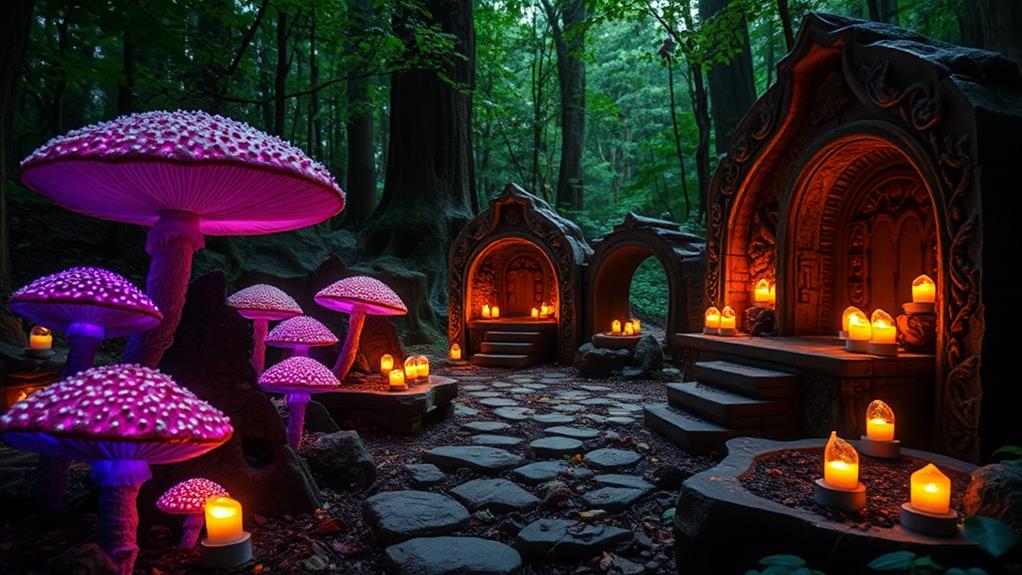
For centuries, ancient cultures have viewed mushrooms as sacred tools for spiritual connection and transformation. These remarkable fungi played a crucial role in rituals and ceremonies, helping people achieve altered states of consciousness.
You might be surprised to learn how various indigenous cultures embraced these practices:
- Mesoamerican Civilizations: The Mixtec and Aztec used psilocybin mushrooms in religious ceremonies, seeking visions and insights that connected them with their ancestors and the cosmos.
- North American Tribes: Puffball mushrooms were utilized in healing rituals, believed to possess medicinal properties that treated wounds and fostered spiritual wellbeing.
- Mazatec People: In Mexico, shamans guide community members through curanderismo, where psilocybin mushrooms are consumed to invoke spiritual healing and guidance during ceremonies.
- Ancient Greeks and Romans: Archaeological evidence suggests they incorporated psychoactive substances, like kykeon, into their rituals, highlighting a longstanding tradition of using psychedelics in spiritual practices.
These sacred mushrooms not only served as a bridge to the divine but also enriched the spiritual lives of countless individuals throughout history.
Their legacy continues to inspire and intrigue many today.
Traditional Healing Systems and Applications
While many ancient cultures revered mushrooms for their spiritual significance, they also recognized their powerful medicinal properties, integrating them into traditional healing systems.
In ancient civilizations like China and India, mushrooms played a crucial role in traditional medicine. For instance, Reishi and Shiitake mushrooms were used not just for their flavor, but also for their ability to support the immune system and promote vitality, as evidenced by enhanced immune function linked to these fungi. This connection tied back to concepts like Qi in Chinese culture and balance in Ayurveda.
Indigenous North American tribes also valued mushrooms, using puffball mushrooms as a therapeutic agent for wound healing. They understood the importance of these natural resources in treating injuries and infections.
The use of Ganoderma lucidum in traditional Chinese medicine dates back thousands of years, where it was cherished for its anti-inflammatory and longevity-enhancing effects.
Historical texts reveal that mushrooms were part of ritualistic and healing ceremonies, emphasizing their significance for both spiritual and physical well-being.
Today, modern studies confirm that mushrooms contain bioactive compounds, validating the ancient claims about their health benefits and therapeutic applications. This rich history showcases how mushrooms have been integral to healing practices across cultures.
Scientific Validation of Ancient Claims
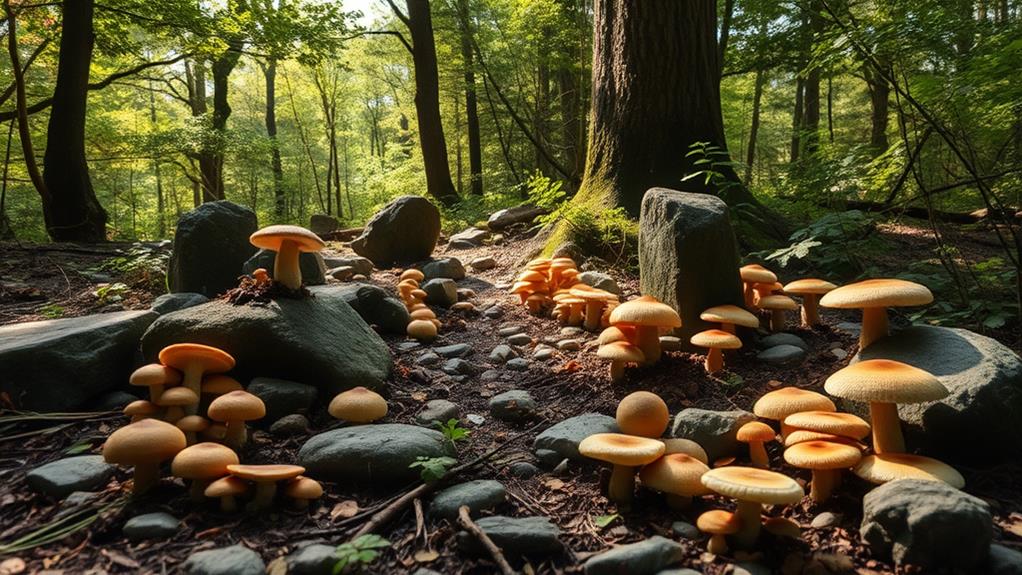
Ancient claims about the medicinal properties of mushrooms have found strong support in modern science. Researchers have uncovered fascinating evidence that validates historical uses, bridging the gap between ancient practices and contemporary medicine.
Here are four key findings that highlight this connection:
- Bioactive Compounds: Studies identify compounds like beta-glucans and triterpenes in mushrooms, supporting claims of immune support and anti-inflammatory benefits.
- Ganoderma Lucidum: Research on this mushroom reveals over 200,000 unique compounds, aligning with ancient Chinese medicine's focus on vitality and longevity.
- Psychedelic Research: Clinical trials show that psilocybin therapy significantly reduces depressive symptoms, affirming the historical use of psychoactive mushrooms for mental health treatment.
- Modern Extraction Methods: New techniques have uncovered active constituents that validate historical uses in naturopathic medicine, showcasing their medicinal potential.
The integration of this rich history with modern science highlights the therapeutic promise of mushrooms in wellness practices today.
As you explore these ancient remedies, remember that they're not just relics of the past; they're gaining traction in the realm of mental health and overall well-being.
Modern Integration of Mushroom Remedies
Mushroom remedies are making a remarkable comeback in today's wellness landscape, blending centuries-old traditions with modern science. You might be surprised to learn that various mushroom species have been used for healing in traditional Chinese and Ayurvedic medicine for thousands of years.
As more people seek plant medicines, the history of psychedelics has also sparked interest in the potential benefits of these fungi.
Recent research shows that bioactive compounds in mushrooms, like beta-glucans and polysaccharides, can support immune health and improve cognitive function. Modern extraction methods have unlocked these powerful constituents, allowing you to find mushroom extracts, teas, and supplements that align with ancient healing practices.
In modern times, integrating mushrooms into your health routine can help tackle common issues such as stress, inflammation, and fatigue. This blend of traditional wisdom and modern science highlights the potential of mushroom remedies to address contemporary health needs.
As society increasingly shifts toward holistic health approaches, the continued exploration of medicinal mushrooms promises to reveal even more therapeutic applications. So, whether you're curious or convinced, it's time to consider how these ancient remedies can enhance your well-being today.
Future Directions in Mushroom Research
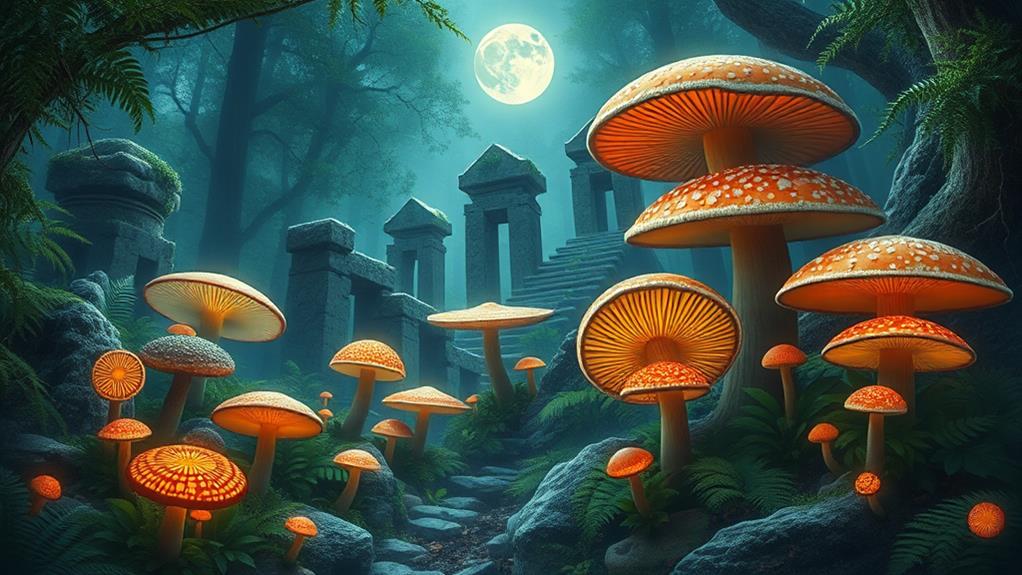
As you explore the future of mushroom research, you'll find exciting advancements in extraction techniques that reveal new bioactive compounds.
These discoveries could lead to innovative therapeutic applications, enhancing both health and wellness.
Plus, understanding mycelium's role in ecosystem health highlights the importance of mushrooms not just in medicine, but in our environment as well.
Emerging Extraction Techniques
In recent years, the field of mushroom research has witnessed a surge in innovative extraction techniques that promise to revolutionize how we harness their medicinal properties.
These modern methods not only enhance the bioavailability of bioactive compounds but also reveal a broader spectrum of therapeutic applications. You might be excited to learn about several key advancements:
- Advanced Solvent Extraction – This technique efficiently isolates beneficial compounds from mushrooms.
- Supercritical CO2 Extraction – This method preserves the integrity of delicate bioactive compounds, enhancing their effectiveness.
- Mycelium Cultivation – Researchers are tapping into both fruiting bodies and mycelial biomass, maximizing the health benefits derived from mushrooms.
- Integration of Technologies – These modern extraction techniques bridge ancient healing knowledge with contemporary medical practices, unlocking previously unavailable active constituents.
As you explore these emerging techniques, you'll see how they could lead to new therapeutic applications.
This ongoing research expands the role of mushrooms in integrative health and wellness solutions, offering exciting possibilities for future healing practices.
Mycelium in Ecosystem Health
Mycelium plays a pivotal role in maintaining ecosystem health, acting as nature's underground network that supports nutrient cycling and soil vitality. This fascinating structure, which you might think of as the roots of fungi, breaks down organic matter, helping to recycle nutrients essential for plant growth.
In fact, some mycelial networks can extend over 12.9 kilometers within just a cubic inch of soil, showcasing their vast influence on soil structure and nutrient availability.
Mycelium forms symbiotic relationships with plant roots, enhancing their health by promoting nutrient uptake and increasing resilience against pathogens. This is especially important for indigenous plants, as their survival often hinges on these vital connections.
The largest known organism on Earth is a mycelial mat of honey mushrooms in Oregon, covering an astonishing 890 hectares. This incredible reach demonstrates mycelium's significant ecological impact on forest ecosystems.
As researchers explore the potential of mycelium further, the advances in understanding its role in ecosystem health may lead to innovative applications.
From supporting sustainable agriculture to uncovering new medicinal compounds, the future of mycelium research is as exciting as it's essential.
Novel Therapeutic Applications
The interconnectedness of mycelium in ecosystems not only supports plant health but also opens doors to novel therapeutic applications in modern medicine.
As you explore the fascinating world of mushrooms, you'll discover how these ancient allies are becoming vital in contemporary treatments, especially for conditions like post-traumatic stress disorder. Recent advances in extraction methods have made previously hidden active compounds accessible, enhancing their therapeutic applications.
Here are four promising areas for future research:
- Immune Support: Compounds like beta-glucans found in mushrooms may bolster your immune system.
- Cognitive Enhancement: Triterpenes could improve memory and mental clarity, helping with cognitive decline.
- Holistic Health Integration: Traditional practices are merging with modern science, bringing mushrooms into wellness routines.
- Sustainable Health Practices: Continued exploration of mushrooms' roles in ecosystems can lead to eco-friendly therapeutic applications.
As ongoing studies delve into the long-term benefits of these medicinal mushrooms, their acceptance in clinical settings continues to grow.
This blend of ancient cultures and modern science holds great promise for enhancing our health and well-being.
Conclusion
In conclusion, ancient cultures recognized the healing power of mushrooms long before modern science validated their benefits. For instance, studies show that over 2,000 species of mushrooms have been used for medicinal purposes throughout history. This rich heritage highlights the importance of these fungi in traditional healing practices worldwide. As we continue to explore their potential, it's exciting to think about how these ancient remedies can shape future health solutions and enhance our understanding of natural medicine.
